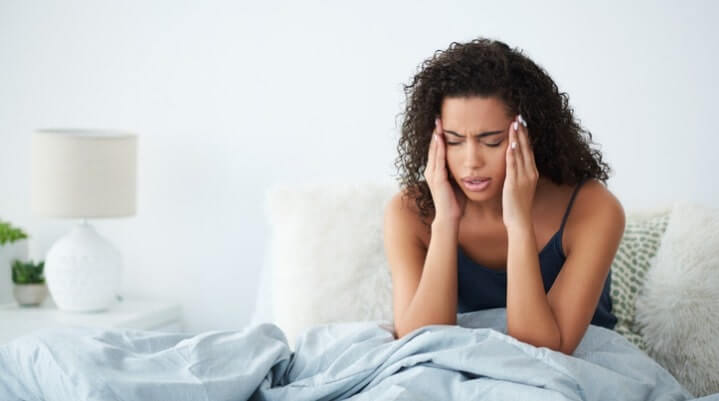Migraine: what every sufferer needs to know

Migraines are a hidden health crisis, with 6 million people in the UK suffering from the illness. Every day, approximately 190,000 migraine attacks are experienced across England.
Migraines are also two to three times more common in women than men. Women in their teens and even into their 40s and 50s are most likely to struggle with migraine.
But what is migraine? Are there different types of migraine, and what can trigger them? In this article, King Edward VII’s Hospital Consultant Neurologist, Dr Sam Chong, addresses this and more – including common misconceptions about migraine, how it can affect mental health, and recent developments in treatment.
What is a migraine?
A standard definition of migraine is: ‘a recurrent throbbing headache that typically affects one side of the head and is often accompanied by nausea and disturbed vision’ (Dictionary.com). However, there is much more to migraine than this – and it’s much more than a simple headache.
The International Headache Society’s definition expands further, recognising that there are two main types: migraine without aura and migraine with aura.
Here’s how to accurately distinguish between the two types:
Migraine without aura
Their definition of migraine without aura is:
A. At least five attacks fulfilling criteria B-D, set out below:
B. Headache attacks lasting from 4-72 hours (untreated or unsuccessfully treated)
C. Headache has at least two of the following four characteristics:
- one-sided location
- pulsating quality
- moderate or severe pain intensity
- aggravation by or causing avoidance of routine physical activity (e.g. walking or climbing stairs)
D. During headache, at least one of the following:
- nausea and/or vomiting
- photophobia and phonophobia (meaning increased sensitivity to light and sound)
Migraine with aura

Migraine with aura has the same definition as above, plus:
A. At least two attacks fulfilling criteria B and C set out below:
B. One or more of the following aura symptoms:
- visual – such as: seeing dots, shimmering patches or curves, coloured spots, sparkles, stars, flashing lights, zig zag lines, blind spots and getting tunnel vision, vibrating visual field, size and shape distortions.
- Sensory – abdominal symptoms such as nausea or a rising sensation in the stomach, sudden anxiety or fear, feeling separated from your body, sensation of limbs or teeth growing, feeling overheated.
- speech and/or language – this includes difficulty speaking and finding the right word/s.
- motor – causes muscle weakness or paralysis to one area or side of the body.
- brainstem – symptoms such as: slurred speech, vertigo, tinnitus or ringing in the ears, hearing disruption or impairment (not including ear fullness), double vision, decreased control over bodily movements, decreased level of consciousness.
- retinal – this includes an aura which may last 5-60 minutes in one eye, and may come without the head pain from a migraine attack.
C. At least three of the following six characteristics:
- at least one aura symptom spreads gradually over more than 5 minutes.
- two or more aura symptoms occur in succession.
- each individual aura symptom lasts 5-60 minutes.
- at least one aura symptom is unilateral (affecting only one side of the eye or body).
- at least one aura symptom is positive (positive can encompass any of the following: flash hallucinations, flash blind spots, visual distortions and sense of heat wave).
- the aura is accompanied, or followed within 60 minutes, by headache.
Phases of a migraine: the science
Migraine attacks arise from disordered sensory processing in the brain and can be divided into a number of phases:
Initial phase: symptoms and signs
During the initial phase, you may notice symptoms including:
- changes in mood
- irritability
- fatigue
- food cravings
- repetitive yawning
- stiff neck
- light sensitivity.
Studies looking at this phase have shown altered activity in an area at the base of the brain known as the hypothalamus, a structure usually concerned with controlling hormones, regulating temperature, mood, appetite, emotions, sleep and maintaining many non-conscious functions.
Next phase: aura (for migraines with aura)
The next phase is the aura, if you have this. A wave of altered brain activity known as cortical spreading depression (CSD) moves across the surface of the brain and will cause different aura symptoms, depending on the area of the brain where this occurs.
The most common brain areas involved are the visual processing occipital lobes. That is why visual auras, such as bright zig-zag lines, visual loss and distortion, are common.
If CSD occurs in the parietal lobe, which processes sensory information, you might experience tingling followed by numbness. If it occurs in parts of the frontal lobe concerned with motor function, this may cause paralysis. Most auras last less than 60 minutes.
The painful phase: the migraine
Next is the painful phase, where your heightened neural activity spreads to the sensory pathways of the trigeminal nerve and brainstem, causing headache, neck stiffness and sensitivity to bright light, sounds and smells.
The release of certain neurochemicals (similar to neurochemicals produced in the skin after injuries such as sunburn) causes the blood vessels in the brain to dilate and heightened pain processing. This phase typically lasts for 24-48 hours.
Post-migraine phase
Even after your migraine has settled, you’re likely to still feel heightened sensitivity to light, smell, sounds and skin. Ordinarily non-painful stimuli – such as droplets of water when showering – can feel painful.
This is often described as the migraine ‘hangover’, as the hyperactive neural processing from the migraine slowly returns to normal baseline levels.
Types of migraine

Different types of migraine reflect the areas where altered brain activity is at its most prominent:
- Basilar migraine
If the blood vessels at the base of the brain are involved, this causes basilar migraine, with double vision, dizziness, slurred speech and even unresponsiveness, potentially.
- Vestibular migraine
If the altered activity involves brain structures concerned with balance, this causes vestibular migraine, with unsteadiness, dizziness and imbalance, sometimes without an accompanying headache. These symptoms can last minutes, hours or even days.
- Hemiplegic migraine
Hemiplegic migraine involves the parietal lobe which, as mentioned earlier, processes sensory information. This form of migraine affects brain structures that control motor function. Paralysis lasting hours, or even days, can occur, with gradual recovery.
- Abdominal migraine
So-called abdominal migraine is where the most prominent symptoms are nausea, vomiting and bloating, with abdominal pain.
- Retinal migraine
With retinal migraine, there are visual symptoms confined to one eye. It’s believed the altered activity in this instance is confined to the nerves and blood vessels in that eye.
What causes migraine?
Primary migraine is caused by a combination of genetic factors: that is, you are born with a tendency to inherit it from your parents, which is triggered when you encounter certain risk factors. The genetics is complicated and multiple genes are likely to be involved.
Secondary migraine attacks are episodes with migraine symptoms, caused by an underlying disease. For example, patients with mitochondrial disorders or autoimmune disorders such as Systemic Lupus Erythematosus (SLE) can experience attacks very similar to migraine, caused by specific pathological processes.
What are some migraine triggers?

Some common migraine triggers include:
- Dehydration
- Citrus fruits
- Cured meats such as bacon, salami and ham
- Alcohol, especially red wine
- Food additives such as monosodium glutamate (MSG)
- Lack of sleep or too much sleep – you can get a migraine caused by a ‘lie-in’
- Excitement – looking forward to something
- Strong smells
- Bright lights
- Stress – weekend migraines, after a week of stress at work, are common
What are some common misconceptions about migraines?
There are many misconceptions about migraines, the most common being:
- It can be cured
Migraines can be controlled – but if you’re prone to getting them, unfortunately you’ll always be vulnerable to attacks, although they may become very infrequent. You may not have an attack for many years so the migraine appears to have disappeared and been ‘cured’ – but the vulnerability to getting one remains. - It will go away with the menopause
Hormonal-related migraines specifically often do stop after menopause, when hormone levels are consistently low. However, this isn’t always the case and other factors can still cause migraine. - It’s just a headache
Migraines are much more severe and debilitating than a standard headache. - You can’t have a migraine without a headache
Actually, you can! If you have a so-called ‘typical aura without headache’, you’ll experience a host of other symptoms of migraine, including: dizziness, visual changes, chest pains, nausea and vomiting without the headache aspect. - Food allergies can cause migraine
Some people spend a lot of money to get a food allergy skin test for migraine. However, there is no evidence that such tests have any predictive value in preventing migraines.
Migraine and mental health
Migraine isn’t just debilitating physically. People who suffer from migraine are two times more likely to also experience depression and three to five times more likely to have anxiety (including panic attacks, phobias and post-traumatic stress disorder). Equally, people with anxiety and depression are also more likely to experience difficult-to-control migraine.
Aside from the psychological effects, large studies have also reported that those with migraine often say it affects their family life, influencing their decisions to have children and causing financial worries, as migraine attacks can interfere with their job.
How can I manage migraine?

Although migraine can be tough physically and mentally, you can take steps to manage it. Keep a diary of your activities, as well as what you eat and drink, to look for triggers and avoid them as much as possible.
On its own, one single trigger may not always be sufficient to cause an attack. However, some triggers have a combined effect that can induce a migraine.
For example, if you have a glass of wine during certain times of your menstrual cycle and have a late night, these three factors (hormonal, alcohol and sleep disturbance) may be sufficient to cause an attack.
Keeping a diary helps you to see the patterns of your biggest triggers so you can avoid them.
When should I seek treatment for migraine?
It’s advised you seek treatment when:
- Migraine causes significant disruption to your everyday life.
- Attacks are getting more and more frequent.
- You experience symptoms not typical for your usual migraine.
- You are taking pain killers frequently to control headaches: this increase the risk of medication overuse headaches.
The first step is to talk to your GP. They can suggest over-the-counter medications that can help. If these don’t relieve your migraine, you may be referred to a specialist and prescribed stronger medication or offered other treatments.
Recent developments in treatment
Migraine medications and treatments are evolving all the time, and a specialist can give you a steer on the best medicine for you at the time you see them.
Some recent innovations include:
Technology
A number of devices are being developed for treating and preventing migraine, including: transcranial magnetic stimulation, vagal nerve stimulation and transcutaneous electrical stimulation devices.There have been some positive outcomes from studies but these treatments are not yet funded by the NHS.
Injections
Anti- Calcitonin Gene Related Protein (CGRP) antibodies
These are injections that you can give yourself on a monthly basis. They help to prevent blood vessels from dilating in the brain, which happens during a migraine attack. These appear to be more effective when other treatments fail. At least five are being developed and some are available on the market.The Scottish NHS have funded some of these treatments but NICE in England and Wales has not yet approved NHS prescription of these drugs.
Occipital nerve block
There is evidence that these injections are effective in alleviating an acute migraine attack. Medical literature also reports that this procedure is effective in the longer term, for reducing severity, frequency and painkiller consumption for migraine patients.
Botulinum toxin injections
These have also been shown to be effective in reducing the frequency of migraine attacks and have been recommended by NICE for patients with chronic migraine.
Support for migraine sufferers
Migraine can be a condition that is very difficult to live with. However, it doesn’t need to control your life. There are so many treatments available to help you.
If you want to find out more about migraines but don’t know where to look, The Migraine Trust is a great place to start. They’re a nationally renowned charity and provide lots of tips and advice on their website.
More information
- If you suffer from migraines, the first step in getting a diagnosis is making an appointment with your GP. They can then refer you to a specialist, who can discuss your treatment options with you. (Don’t have a GP?)
- Dr Sam Chong is an expert in migraine and chronic pain and can provide expert treatment, advice and guidance. Make an enquiry.









